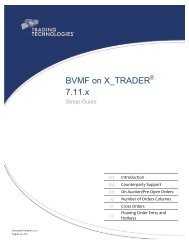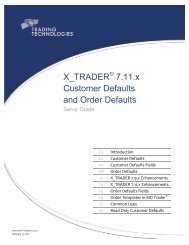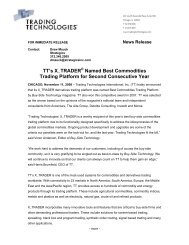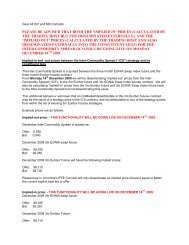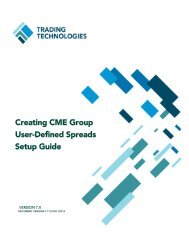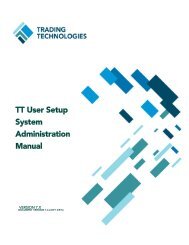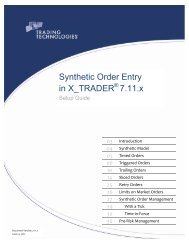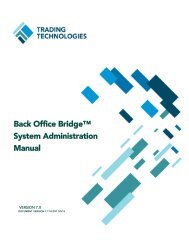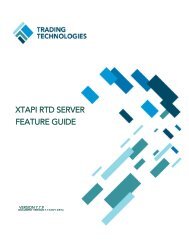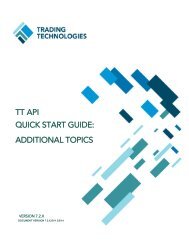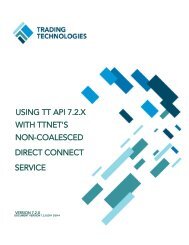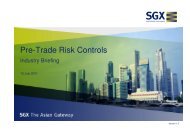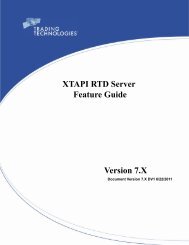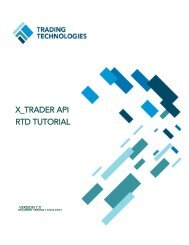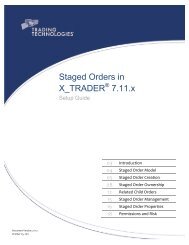TT CME Gateway System Administration Manual - Trading ...
TT CME Gateway System Administration Manual - Trading ...
TT CME Gateway System Administration Manual - Trading ...
Create successful ePaper yourself
Turn your PDF publications into a flip-book with our unique Google optimized e-Paper software.
4<br />
Understanding the Price Feed<br />
<strong>TT</strong> <strong>CME</strong> <strong>Gateway</strong> <strong>System</strong> <strong>Administration</strong> <strong>Manual</strong> 59<br />
<strong>Trading</strong> Technologies International, Inc.<br />
Configuring Market Data<br />
Price Server Files During normal operation, the Price Server reads:<br />
• Hostinfo.cfg to determine the subjects (product data) to which it must<br />
subscribe.<br />
• fast.cfg to obtain each subject’s connectivity information (i.e., channel<br />
number, IP addresses, ports, etc.)<br />
Also, at startup and after a product download, the Price Server reads the price<br />
data in Exchange-flavor_Mode_ttqap.dat to include previously traded<br />
contracts when calculating VAP for <strong>TT</strong>QAP-subscribed products.<br />
<strong>TT</strong> <strong>Gateway</strong> Subscription<br />
Process<br />
FIX/FAST Message<br />
Recovery<br />
At startup and during operation, the Price Server reads the hostinfo.cfg file to<br />
determine:<br />
• The various subjects that it must download as specified by the Subject#<br />
parameters.<br />
• The NIC IP addresses (on the local machine) over which the <strong>TT</strong> <strong>CME</strong><br />
<strong>Gateway</strong> routes the various MDP feeds. In the example above, these feeds<br />
are FeedA and FeedB (as illustrated in the AddressFeed* parameter). For<br />
details on routing MDP feeds, refer to the section called Configuring<br />
Multiple NIC Setup on page 41.<br />
After identifying these subjects, the Price Server refers to the fast.cfg file to<br />
determine the connectivity information on how to obtain the subject data from<br />
<strong>CME</strong> Group.<br />
The <strong>TT</strong> <strong>CME</strong> <strong>Gateway</strong> order book is updated incrementally with market data per<br />
contract. If message recovery is necessary, the <strong>TT</strong> <strong>CME</strong> <strong>Gateway</strong> subscribes to<br />
snapshot channels to update the entire Order Book. Because the snapshot<br />
updates occur at a high message rate, subscribing to all snapshot channels<br />
simultaneously is not recommended. To help alleviate recovery issues, the Price<br />
Server is configured by default to do the following:<br />
• Use FIX/FAST incremental updates to refresh the Order Book.<br />
• Subscribe to the snapshot channels only when the incremental update has<br />
not refreshed the entire Order Book.<br />
• Dynamically subscribe to no more than two snapshot recovery channels at<br />
one time.<br />
• Only subscribe to snapshot channels for contracts with active price<br />
subscriptions. However, if an order is entered outside the displayed levels<br />
of depth for a contract that missed an inside market price update, the Price<br />
Server will not request a snapshot to refresh the Order Book. If an order is<br />
entered within the levels of depth, the snapshot is requested as needed.<br />
This FIX/FAST recovery behavior is defined by the MaxSnapshotChannels<br />
parameter in hostinfo.cfg. Because the parameter is not present in the<br />
hostinfo.cfg file by default, you’ll have to manually add the<br />
MaxSnapshotChannels parameter if you want to reconfigure the number of<br />
snapshot channels to subscribe to. By default the Price Server functions as if the<br />
parameter is set to 2.



